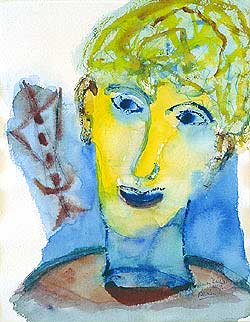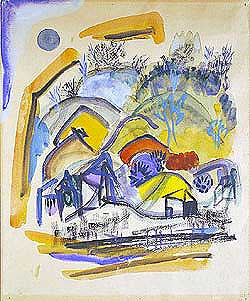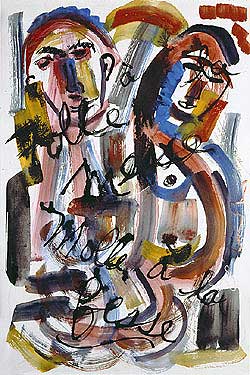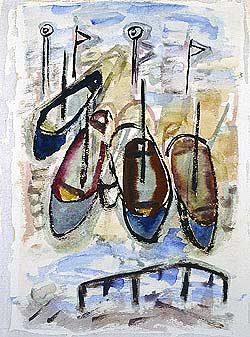Dear Artist,
In 1960 Henry Miller wrote Paint as You Like and Die Happy. Noel Young, his publisher, gathered paintings from the far corners — watercolours, gouache, sketches, drawings — most of them gifted or bartered to his many friends. The book has a bit of a cult following and has gone through several editions. Miller actually painted “on the side” for about fifty years. To him each painting was an adventure. “It’s the pleasure of picking up the brush and seeing what happens,” he said. Miller’s joy of living and wide-ranging curiosity comes through, and he was indeed painting when he died at age 88. His paintings are now collected as much for his literary celebrity as for their spontaneity and childlike innocence. The influence of Picasso, Elie Faure, Matisse and others are noted — but so what — don’t all of us lean on our masters? He painted anything that came to mind or hand — portraits, landscapes, mindscapes, dreamscapes, boatscapes.
In the sixties Miller and I had a correspondence and a bit of a friendship. I had written him in praise of “Bread.” This was an essay on the worldwide variations and qualities of bread. It was playful — it jerked your mind around and shocked, but to my eyes it was totally thought out and crafted. His creative imagery appealed to me terribly. When we met in Big Sur, he was having a tough time. His Paris days were behind him. Now married to Janina Lepska and raising two young children, they were living in a low-cost holiday home among the trees. On the porch and on their kitchen table were some of his watercolours. While Miller and his paintings were attached at the hip, he didn’t seem to take them seriously. “Slops,” he called them.
Miller claimed that he was losing his edge as a writer and was now more than ever getting a kick out of painting. In this medium he didn’t have the same expectations that he had for his writing. “I just love it,” he said, “Maybe it’s because anything goes.” Many literary figures have found escape in the brush: Lawrence Durrell, Victor Hugo, William Thackeray, to name but a few. In the Die Happy book, Miller talks of the appeal of painting and analyzes motivations in classic essays such as To Paint Is to Love Again, The Waters Reglitterized, and The Painting Lesson.
Best regards,
Robert
PS: “Henry kept his paintings separate from his writing. It’s as though stories came from the other side of his brain.” (Noel Young)
Esoterica: Miller explained his technique to his friend Lawrence Durrell: He called it “The New Instinctivism.” You closed your eyes and wished images to form under your brush. Memories were important but references were not. The main effort was to will the image — to allow a dream to materialize. A line was to go on a voyage of discovery. “In every man’s heart there is anchored a little schooner.” (Henry Miller)
Henry Miller (1890-1980)
Related technique
by Ankevmul, Maine, USA
The Henry Miller technique of closing one’s eyes and producing what the imagination projects through the brush reminds me of a related technique pioneered by Marion Milner (who also wrote under the name Joanna Field), a British psychoanalyst, who used “Free Drawing” as a way to get blocked and severely traumatized clients — or those suffering from autism — to express themselves. They were given paper and pencil and encouraged to doodle — the therapist would then talk about the images, ask about them, speculate about what they might be. This often unleashed an emotional release in a flow of words. Milner saw this as a way of letting unconscious material surface, and indeed “art therapy” is a respected professional approach today. A similar tool used often by writers is free writing where one just lets the words flow without any attempt to edit or censor. Peter Elbow was one of the first proponents of this idea, adapted since by many writers and teachers. Again, the idea is to let whatever happens happen — such delightful surprises often lead us into important discoveries for work that can be polished and finished later.
Henry Miller’s inspiration
by oliver, Houston, TX, USA
I like the short essay on Miller from the Monterey County Historical Society. Miller evidently says he lost his passion, but was happier without it: “It’s a curse,” he says, “Yes, it’s a flame. It owns you. It has possession over you. You are not the master of yourself. You are consumed by this thing. And the books you write. They’re not you. They’re not me sitting here, this Henry Miller. They belong to someone else. It’s terrible. You can never rest. People used to envy me my inspiration. I hate inspiration. It takes you over completely. I could never wait until it passed and I got rid of it.” But evidently it was those days of possession/passion that produced his best work. Perhaps Miller was able to assess the products of both sides of his brain, and compared to the achievements in writing, he knew his painting was just not on the same level.
Henry Miller incompetent
by Anonymous
I’m surprised at Robert for including a tribute to the incompetent Henry Miller. His writing was based mainly on crude bombast and when he couldn’t make a go of that he spun off those amateur dabblings and sold them where and to whom he could for what the market would bear. A notorious person of extreme bad taste can get away with this sort of thing but history will see otherwise. His pictorial work has no craft or style and it’s all over the place. To some degree as a writer, and certainly as a person and a painter, Miller was a dud.
Painting as natural medication
by Moncy Barbour, Lynchburg, VA, USA
Henry Miller’s art makes me feel relaxed in a time of tension. I can see the Picasso philosophy in his work and his own philosophy by word and paint as well. Matisse painted for the man of letters to be let down easy at the end of a long day. This indeed is the effect that Miller’s work has on me. I believe that he found his truth through painting as a natural medication. It is no wonder that he prospered such a long life. What he called his “slop” is a feast and inspiration for myself. The sad part is that he has encouraged me to just paint what is truth to myself and he will never know that.
Generosity and success
by Jennifer Garant, Naramata, BC, Canada
Fifteen years ago I received from a sculptor Paint as You Like and Die Happy. I passed it on to an aspiring new painter about 2 years ago. I was reminded — and will go and get the book again for myself — that it is the applying of paint and the journey that is painting — and that sometimes the shadow of destination looms over me and sucks out and chills the light and inspiration, the joy that we have all experienced from a painting that was painted because we simply needed to paint it. Recently I watched a neophyte artist being bitten with the bug with a little bit of help and encouragement from me. It was truly amazing to watch. I felt his enthusiasm and his need to paint and saw his brain kick into overtime and doors that he had no idea existed open in his mind. I often wonder with you and Henry Miller who activate, motivate and nurture artists with such generosity of knowledge and honesty if you ever sit back and bask in the success you have created on so many levels for others. My Dad used to say, “Generosity is a nice compliment to Success.”
Hay in her hair
by Linda Karius, Kelowna, BC, Canada
The subject phrase Paint as you Like and Die Happy causes me to look at a quote I have on my bulletin board at my desk on which I have pictures of family, a drawing of mine, and other pictures that help to inspire my creativity, fitness and general good humour. The quote states: “Life is not a journey to the grave with the intention of arriving safely in a pretty and well preserved body, but rather to skid in broadside, thoroughly used up, totally worn out, and loudly proclaiming… WOW… what a ride!” That’ll be me. I expect to live to 100 and enjoy every bit of it! And to heck with being an old woman in a rocking chair… I’ll expect I’ll die with hay in my hair and rubber boots on my feet. I totally love these twice-weekly letters. They are inspiring and thought provoking to all aspects of my creative and active life!
More complicated art needed
by Yaroslaw Rozputnyak, Moscow, Russia
Die happy looks different in different societies. For us life level support is more difficult with each day. The tendency here is that simple art can be done with Wacom PC tablet pen and it has become not popular to use paint. Here, simple tapestries are made by a machine. Nobody in Moscow will buy simple hand made imaginative tapestry exercises as it was in Soviet time. They have no importance for the contemporary customer. A selling artist must create complicated art in order not to be a competitor with a machine.
Insight into Henry Miller
by Ariane Goodwin
As I sit here, facing the large bulletin board, I see several black and white photos of Val Miller and me, Ane Neiman (aka Ariane Goodwin). We’re about four, I’m guessing. In one, we’re sitting down, crammed into a tin tub on the outside porch of our Anderson Creek home, a long building that was once the infirmary for the men who built Highway One. In the other, Val is standing up crying, while I hang onto the side of the tub, looking up at her, also crying. She was the mean one, always has been, though I have high hopes for the aging process to smooth out the rough edges. Tony has not yet been born. I’m imagining that Lepska (their mother’s first name by the way is not Janina), and my mother are watching as Man Ray clicks away. My mother, Margaret Neiman (wife of Gilbert Neiman — erstwhile author and lifelong jealous friend of Henry’s — mother of me, watercolorist, and long time friend and drop dead gorgeous model of Man Ray) was actually the one who taught Henry how to paint. She was also the one to introduce Man Ray to Henry. Now, does the good man ever give her public credit for being his first teacher? Nope. Did I even know about this while my mother was alive? Nope. Another friend told how Henry asked Margaret to show him how to paint after seeing her watercolors. He even boasted about signing his name to some of her work and sending them out for cash. Whew! Now that’s the Henry I knew and never quite grew to love. (Try being a shy, introverted little girl at his dinner table politely asking to be excused and have him holler out: “Need to take a piss? Why not just go out in the garden and piss out there?”) Goodness, how the soft shape of history moves under the gender lens. So, is all this just so much speculation, I mean the watercolor stuff? Nope. Unless there’s some part of To Paint Is To Love Again that I missed. Could be. Can’t say he’s one of my favorite authors, except for the Smile at The Foot of The Ladder. I recently found, among his numerous letters to my mother, besides the ones she burned, the one in which he asks her permission to sign his name to her paintings. Guess she said “yes,” yes? So, somewhere out there are my mother’s paintings with Henry’s name on them. She stopped painting when I was born. Sold some to the LA County Museum, but they can’t find them. That only leaves me the one she painted of Lepska, who is still alive, and has kindly put that one in her will for me. Henry and Lepska were married in Boulder, CO, with my mother and father their only witnesses. Henry dedicated The Air Conditioned Nightmare to my parents.
(RG note) Ariane Goodwin is the author of Writing the Artist Statement: Revealing The True Spirit of Your Work.
Bread and varnish
by Maria Guarin, Bogota, Colombia
I started to paint after I raised my kids and although I’ve had many good teachers, I didn’t have a formal college training and lack some knowledge on techniques although I managed to read and experiment a lot, discovering on the way some processes for textures which I enjoy greatly. I liked the slide show; the totem pole looked so real, the mountains and background so great and the glazing technique fabulous. I’m going to try it in one of my next paintings. Is UVLS an acrylic agglutinant or primer or what? Talking about Henry Miller and bread, it reminded me of the bread of an island called Old Providence that belongs to our country and is located in front of Nicaragua. The people are descendants of Africans and English. In most of the houses they make the most delicious bread. Instead of water they use coconut milk and many of them bake it with wood fuel in clay ovens.
(RG note) Ultra Violet Light Stabilizers (UVLS) are another reason why acrylic is a super medium. This is a final varnish of a different molecular structure than acrylic medium. It goes a long way to maintain permanence in colour, and trouble-free cleaning.
Loves big and small
Patt Lovato, Mora County, NM, USA
I usually work small, 8×10, and when encouraged to go big, I find I express my ideas very differently. I love the look and feel of both. Two sides of my personality and creativity are brought to light, so to speak. I will continue to develop my larger paintings as they seem to be more free, more expressive, leaving the viewer to imagine what I only have suggested. While my smaller paintings are more detailed and controlled, I find myself painting what I want you to see, no imagination required.
Glazing medium for oils
by Renato Mucillo
Regarding Karen Pettingill’s inquiry regarding glazing with oils, I’ve used and experimented with oil mediums most of my life. The Gamblin Company has been producing pigments and mediums that are really top notch. The mediums are alkyd based and are fast drying (within 24 hours) and non-yellowing, and they don’t darken or crack over time either. This medium can be used with oils, and is helpful in speeding up the production time of oil paintings.
(RG note) Robert Gamblin’s research has resulted in his production of a variety of oil media that achieve different ends and satisfy the needs of different artists. High (sticky) viscosity and low viscosity are two of the variables. When glazing in oil his low viscosity products generally work best. Unless an intermittent glaze is required, “flow” is desirable.
Drug addicted daughter
by Anonymous
I’m wondering if you have any words for someone like me who has been floundering, trying to find their way back to painting, after a long struggle with a drug addicted adult child. My daughter is 32 and I am still neck deep in her drug addiction problems…along with a sweet granddaughter. I read all your letters and as always you are such an inspiration! Do you have anything on this paralyzing subject? I try to paint the torture, but it just ends up in the burning pile! Once in a while something comes out of it.
(RG note) You have to deal with your own distraction-avoidance. Guilt and worry and the sense of failure — “What did I do wrong?” — can be so far into the cranial foreground that nothing else, let alone creativity, seems to work any more. Try this: Start small and provide yourself with controlled private time. Take twenty minutes and play some positive demanding music very loudly — and work energetically at an actual painting during this noise. (Prepare and set up for this bombardment in silence.) You may find you are able to increase the length of time in this loud mode, and you may be able to eventually turn down the volume. The idea is to prime the pump and get your old self back. It isn’t that you are giving up on your full time concern, your daughter, it’s just that you are realigning your cells and building a temporary sanctuary from your burden. For this exercise, don’t paint the torture, paint the dream of no torture.
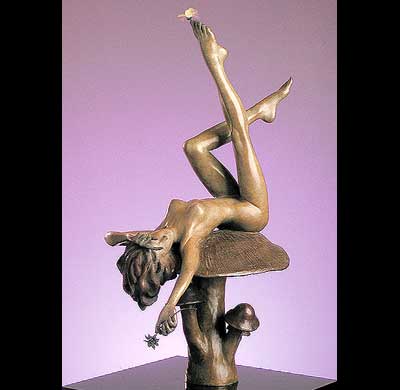
Finally Spring bronze piece |
You may be interested to know that artists from every state in the USA, every province in Canada, and at least 115 countries worldwide have visited these pages since January 1, 2004.
That includes Cindy Sue who wrote, “There is a line in a song, ‘I wish I had a river to skate away on.’ I picture myself in the furthest corner of a lake, where there is just a hint that it continues. This is my river to skate away on. I have no sad reason to skate away. I just imagine the lightness that I would feel at doing so, and it makes me smile.”
And also Katherine Lakeman who wrote, “Music, visual art and writing are all so interconnected. It’s about a way of life, a way of being, that makes all experiences new and filled with wonder.”

